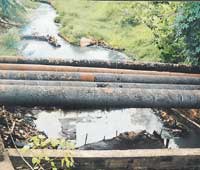Leaking oil
pipes pose danger to Kotahena residents The dilapidated pipeline is more than 50 years old, having been built by Shell in 1948, and residents say that if it is not repaired and precautions taken it could erupt at any moment with devastating results. If by any chance leaking oil gets ignited the explosion would leave this entire densely populated Kotahena area gutted. The fuel oil, which is sold as bunkers to merchant ships calling at Colombo, is stored in huge storage tanks belonging to Lanka Marine Services (LMS) at Kotahena. The more than one kilometre long leaking pipe lines were considered unusable at the time the Public Enterprises Reforms Commission (PERC) called for bids for the privatisation of LMS, then a subsidiary of the Ceylon Petroleum Corporation. It is now a subsidiary of the John Keells conglomerate. While John
Keells was the only company willing to pay Rs 1.2 billion for a
90 percent stake in LMS, 16 others who were pre-qualified by PERC
to bid, withdrew due to the dangerous location of the tanks, the
environmental problems created by the leaking pipes, the corroded
tanks and the high floor price asked for by the seller. U. S. A. Perera, a resident of the area, said that three pipelines were connected to the Bloemendhal Tank Farm and others run to the Sapugaskande oil refinery from Colombo Harbour. Almost all these pipe lines appeared to be very old. Somewhere deep inside the shanty town there is a huge fuel leak seeping into the canal water way. The poor people of the area have dug a drainage line to draw oil from the leak and the entrance is barricaded until a large quantity of thick black fuel oil is collected. Once the collection is big enough the oil is released into the canal water from where it could be absorbed in cloths and put into barrels to be sold. The entire area around the bridge and canal is blackened with oil. The residents have become used to living with the danger, completely ignorant of the massive risk to their lives and property. There are more than 100 shanties apparently on the pipe line. In addition, there are about 150 houses alongside the shanties. Altogether there are around 400 houses with a population of at least 4,000 people between Bloemendhal and Ibbage Watte Junction. The house owners claim that they have valid registration for their properties by the relevant authorities, while the shanty dwellers too claim that they were issued permits by the housing authorities. They say that they pay taxes to the municipality and also electricity and water bills. Although there are residents who could understand the gravity of the danger and the environmental impact, they remain silent as they fear being evicted from their homes. Therefore, they try to resist any attempt of expose to the danger. The Sunday Times FT contacted the Colombo Municipal Council to find out what precautions it has taken to safeguard the people living in the area. Deputy Municipal Commissioner Ananda Jayawardene was unaware of the danger from the old fuel tank farm. He said they have nothing to do with these tanks and was even unaware that the tank farm is now owned by a private company. The Central
Environmental Authority too appeared to be ignorant of the danger.
Assistant Director H.S. Premachandra said in an interview that under
the law if the capacity is less than 150 metric tonnes the license
is issued by the respective local He said that such a license, which is renewed annually, will be issued upon the submission of conditional documents giving an undertaking not to pollute the soil, water or air. Though some concerned environmentalists have petitioned the Central Environmental Authority and the Colombo Municipal Council, both agencies denied that they received any petition or complaint with regard to this fuel tank farm. LMS was a profitable subsidiary of the CPC, owing to high bunker prices in Colombo port. At that time, under state ownership, it had apparently not been willing to spend money to repair the tanks and pipelines, despite making good profits, as it was not considered prudent to continue developing a fuel storage facility in a highly populated area like Kotahena. The construction of a Fuel Tank Farm at an isolated location in Muthurajawela was considered to be safer. |
||||
Copyright © 2001 Wijeya Newspapers
Ltd. All rights reserved. |

